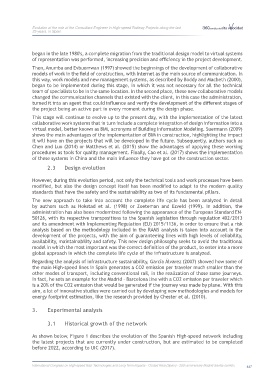Page 449 - 360.revista de Alta Velocidad - Nº 6
P. 449
Evolution of the role of the Consultant Engineer in High-speed Railway Projects along the last
25 years, in Spain
began in the late 1980's, a complete migration from the traditional design model to virtual systems
of representation was performed, increasing precision and efficiency in the project development.
Then, Anumba and Evbuomwan (1997) showed the beginnings of the development of collaborative
models of work in the field of construction, with Internet as the main source of communication. In
this way, work models and new management systems, as described by Boddy and Macbeth (2000),
began to be implemented during this stage, in which it was not necessary for all the technical
team of specialists to be in the same location. In the second place, these new collaborative models
changed the communication channels that existed with the client, in this case the administration,
turned it into an agent that could influence and verify the development of the different stages of
the project being an active part in every moment during the design phase.
This stage will continue to evolve up to the present day, with the implementation of the latest
collaborative work systems that in turn include a complete integration of design information into a
virtual model, better known as BIM, acronyms of Building Information Modeling. Suermann (2009)
shows the main advantages of the implementation of BIM in construction, highlighting the impact
it will have on the projects that will be developed in the future. Subsequently, authors such as
Chen and Luo (2014) or Matthews et al. (2015) show the advantages of applying these working
procedures as tools for quality management. Finally, Cao et al. (2017) shows the implementation
of these systems in China and the main influence they have got on the construction sector.
2.3 Design evolution
However, during this evolution period, not only the technical tools and work processes have been
modified, but also the design concept itself has been modified to adapt to the modern quality
standards that have the safety and the sustainability as two of its fundamental pillars.
The new approach to take into account the complete life cycle has been analyzed in detail
by authors such as Hokstad et al. (1998) or Zoeteman and Esveld (1999). In addition, the
administration has also been modernized following the appearance of the European Standard EN-
50126, with its respective transpositions to the Spanish legislation through regulation 402/2013
and its amendment with Implementing Regulation (EU) 2015/1136, in order to ensure that a risk
analysis based on the methodology included in the RAMS analysis is taken into account in the
development of the projects, with the aim of guaranteeing lines with high levels of reliability,
availability, maintainability and safety. This new design philosophy seeks to avoid the traditional
model in which the most important was the correct definition of the product, to enter into a more
global approach in which the complete life cycle of the infrastructure is analyzed.
Regarding the analysis of infrastructure sustainability, García Álvarez (2007) showed how some of
the main High-speed lines in Spain generates a CO2 emission per traveler much smaller than the
other modes of transport, including conventional rail, in the realization of those same journeys.
In fact, he sets an example for the Madrid - Barcelona line with a CO2 emission per traveler which
is a 20% of the CO2 emission that would be generated if the journey was made by plane. With this
aim, a lot of innovative studies were carried out by developing new methodologies and models for
energy footprint estimation, like the research provided by Chester et al. (2010).
3. Experimental analysis
3.1 Historical growth of the network
As shown below, Figure 1 describes the evolution of the Spanish High-speed network including
the latest projects that are currently under construction, but are estimated to be completed
before 2022, according to UIC (2017).
International Congress on High-speed Rail: Technologies and Long Term Impacts - Ciudad Real (Spain) - 25th anniversary Madrid-Sevilla corridor 447

